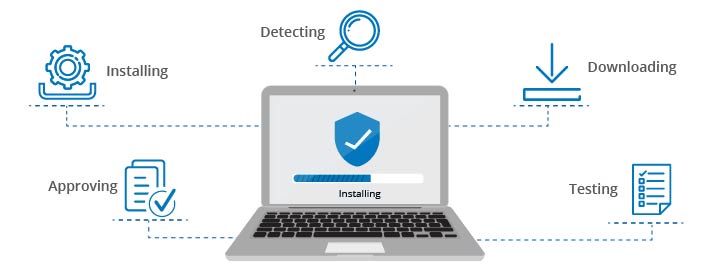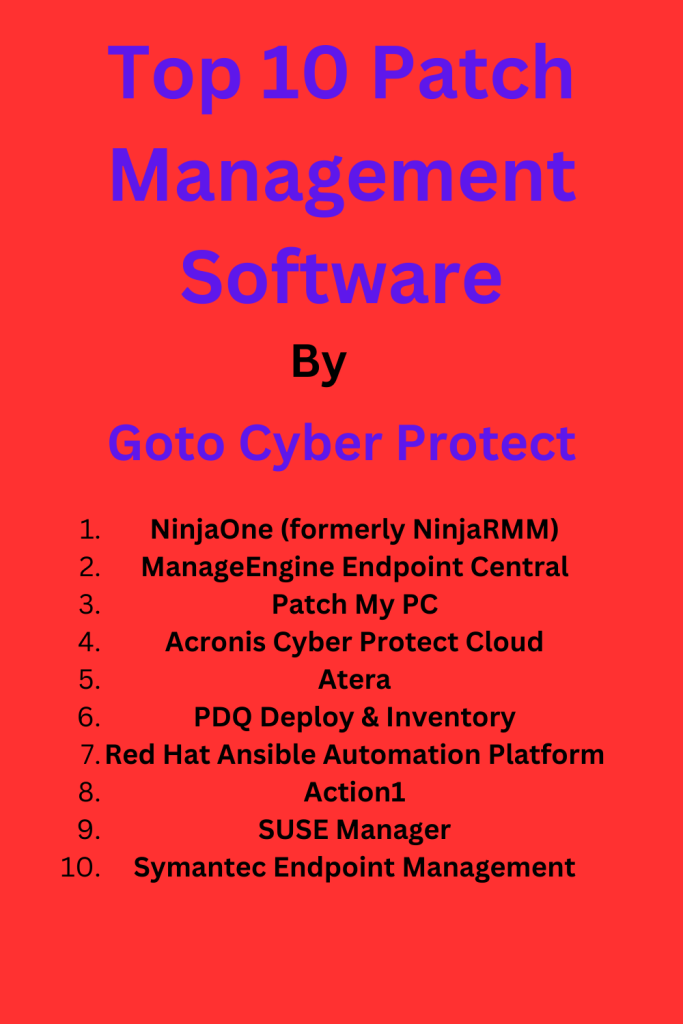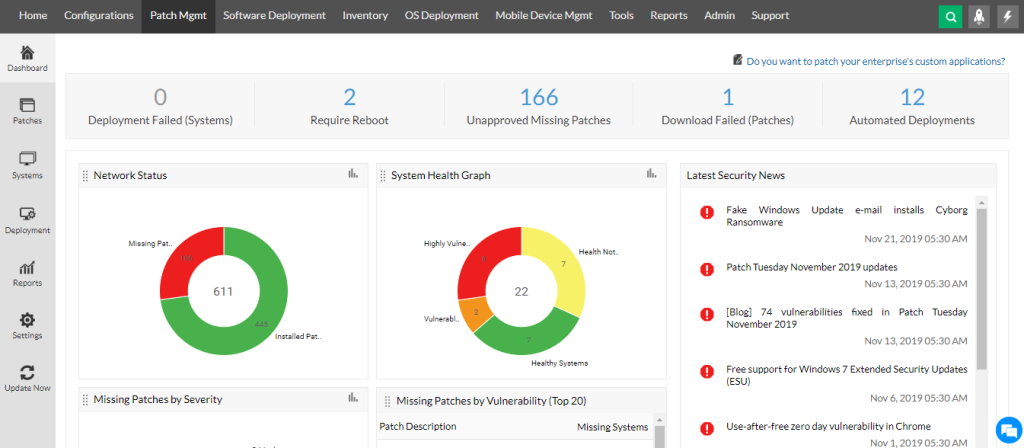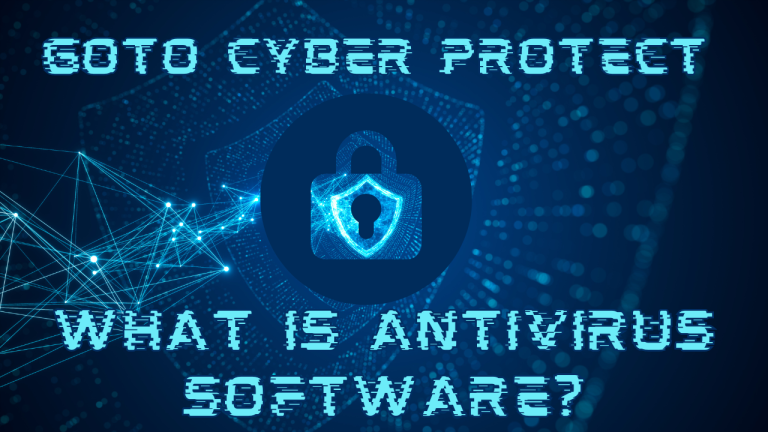Top 10 Patch Management Software for 2024
In an age where cyber threats are constantly evolving, the need for robust cybersecurity measures has never been more critical. At Goto Cyber Protect, we understand that keeping your software up-to-date is a foundational pillar of cyber defense. That’s why we’re diving deep into the world of patch management software, a key player in the cybersecurity arena.
With 2024 upon us, we’ve curated a list of the Top 10 Patch Management Software solutions that are leading the charge in safeguarding digital assets from the latest security vulnerabilities. From the versatility of NinjaOne (formerly NinjaRMM) and the comprehensive control of ManageEngine Endpoint Central, to the simplicity of Patch My PC and the advanced protection offered by Acronis Cyber Protect Cloud, our roundup covers a range of tools designed for every business need.

Whether you’re a small business or a sprawling enterprise, staying ahead of potential security breaches with effective patch management has never been more accessible.
Join us as we explore these trailblazing solutions, including Atera’s all-in-one platform, PDQ Deploy & Inventory’s efficient system management, Red Hat Ansible Automation Platform’s powerful automation, Action1’s real-time endpoint security, SUSE Manager’s Linux system management, and Symantec Endpoint Management‘s industry-leading security features.
Each of these platforms brings something unique to the table, ensuring that businesses can find the perfect match for their specific security requirements. Let’s dive into what makes these patch management softwares the top picks for 2024, and how they can fortify your cyber defenses in the ongoing battle against digital threats.
Top 10 Patch Management Software for 2024

Here’s a quick peek at some of the leading patch management solutions in the market for 2024:
- NinjaOne (formerly NinjaRMM)
- ManageEngine Endpoint Central
- Patch My PC
- Acronis Cyber Protect Cloud
- Atera
- PDQ Deploy & Inventory
- Red Hat Ansible Automation Platform
- Action1
- SUSE Manager
- Symantec Endpoint Management
1. NinjaOne (formerly NinjaRMM)
In the fast-paced world of IT management, NinjaOne emerges as a beacon of efficiency and reliability. With an impressive 4.8 out of 5 stars rating from over a thousand reviews, it’s clear that NinjaOne is not just another tool in the IT arsenal—it’s a game-changer optimized for quick response times. Its recognition as the “1st Easiest To Use in Incident Management Software” is a testament to its user-friendly interface and functionality that simplifies complex IT tasks.
Overview
NinjaOne stands out by automating the most challenging aspects of IT management. It empowers over 17,000 IT teams with unparalleled visibility, security, and control across all endpoints. The platform’s efficiency is not just about managing IT environments; it’s about transforming them. It increases productivity, slashes risk, and significantly cuts IT costs, offering a comprehensive solution that’s hard to beat.
User Satisfaction and Industry Acclaim
What sets NinjaOne apart is its ability to consistently secure top ranks across various categories on G2, including endpoint management, remote monitoring and management, and patch management. Such acclaim is not just about the features it offers but also reflects the world-class support provided to users, ensuring that every IT challenge is addressed promptly and effectively.
Designed For
- IT Managers: NinjaOne is the go-to solution for IT managers looking for an all-in-one platform to streamline their operations.
- Owners: Business owners will find NinjaOne invaluable for keeping their IT infrastructure secure and up-to-date without needing a large IT department.
Industries and Market Segment
Primarily serving the information technology and services, as well as computer & network security industries, NinjaOne is particularly favored by small businesses (52%) and the mid-market segment (45%). This wide adoption is likely due to its flexible pay-per-device pricing model, making it accessible for businesses of all sizes to only pay for what they need, when they need it.
Pricing
NinjaOne’s pricing strategy is as innovative as its platform, offering a pay-monthly, pay-per-device system that ensures businesses can scale their IT management solutions in tandem with their growth. This approach not only makes NinjaOne a cost-effective option but also a flexible partner in IT management. Click here to learn more about their plan and pricing.
Why NinjaOne?
Choosing NinjaOne is choosing a partner committed to revolutionizing IT management through automation, security, and unmatched support. Its accolades and user satisfaction scores speak volumes of its effectiveness and impact, making it an indispensable tool for businesses aiming to fortify their IT infrastructure while optimizing costs.
2. ManageEngine Endpoint Central

ManageEngine Endpoint Central positions itself as a robust solution in the Unified Endpoint Management (UEM) domain, earning a solid 4.4 out of 5 stars from its users. Its rank as the “10th Easiest To Use in Endpoint Management Software” showcases its commitment to providing an accessible and efficient management tool for a wide array of devices.
Overview
Endpoint Central excels in offering a comprehensive suite of desktop management routines that simplify the complex task of managing an organization’s devices. From servers and desktops to smartphones and tablets, including POS devices, it facilitates a centralized management approach. This not only streamlines IT operations but also enhances the overall security posture of the business. Its capabilities include automating patch installations, software distributions, OS deployments, and much more, making it an indispensable tool for IT departments.
User Satisfaction and Productivity
A key to Endpoint Central’s success is its support for a variety of operating systems, including Windows, Mac, and Linux, alongside comprehensive mobile device management for iOS, Android, and Windows platforms. This broad compatibility ensures that IT managers and system administrators can maintain control over their organization’s devices with ease, regardless of the underlying technology.
Designed For
- IT Managers: For those tasked with overseeing IT infrastructure, Endpoint Central provides a powerful yet manageable platform.
- System Administrators: System admins will appreciate the software’s ability to automate routine tasks, freeing up time for more strategic projects.
Industries and Market Segment
Endpoint Central finds its primary users within the information technology and services and financial services industries. With a significant portion of its user base in the mid-market segment (68%) and a notable presence in the enterprise sector (22%), it demonstrates versatility and scalability, catering to a broad spectrum of business sizes and types.
Pricing
Remarkably, ManageEngine offers an entry-level price of $0, making Endpoint Central a highly accessible option for small and medium-sized businesses. This pricing strategy underlines the company’s commitment to providing value-driven solutions that support SMBs in establishing robust IT management practices without the upfront investment typically associated with such comprehensive tools.
Why ManageEngine Endpoint Central?
Choosing ManageEngine Endpoint Central means opting for a solution that not only streamlines the management of a diverse array of devices but also enhances an organization’s security and operational efficiency. Its broad OS and device support, coupled with a scalable architecture, make it a go-to choice for businesses looking to centralize their endpoint management. With its competitive pricing and strong user satisfaction, Endpoint Central stands out as a valuable tool for IT managers and system administrators aiming to optimize their IT environments.
Patch My PC for Patch Management
Patch My PC is a niche solution designed specifically for organizations already using Microsoft Configuration Manager (ConfigMgr) or Microsoft Intune for endpoint management. It focuses on automating updates for third-party applications within those existing platforms. Here’s a breakdown of its key aspects:
Target Users: System administrators and systems engineers responsible for managing third-party application updates within ConfigMgr or Intune environments.
Industries: Patch My PC caters to various sectors, with a focus on IT services and higher education, where managing a mix of applications is common.
Market Segment: Patch My PC targets primarily enterprise (55%) and mid-market (41%) businesses.
Strengths of Patch My PC:
- Deep Integration with ConfigMgr and Intune: Patch My PC integrates seamlessly with your existing Microsoft management tools, leveraging familiar deployment mechanisms like Automatic Deployment Rules (ADR) and task sequences.
- Automated Third-Party Updates: It automates the entire process of finding, downloading, and deploying updates for third-party applications, saving IT admins significant time and effort.
- Compliance Reporting: Gain visibility into your third-party update compliance alongside Microsoft updates, using existing ConfigMgr reports or their advanced reporting solution.
- Security Focus: Patch My PC prioritizes security by providing real-time alerts for new updates, including those addressing security vulnerabilities.
- Ever-Growing Application Catalog: They maintain a comprehensive and constantly expanding catalog of supported third-party applications, reducing manual setup for administrators.
Considerations for Patch My PC:
- Limited Platform Support: Patch My PC is built specifically for ConfigMgr and Intune environments. If you don’t use these platforms, you’ll need to explore alternative patch management solutions.
- Pricing Structure: While their per-device pricing might seem attractive, costs can scale quickly for larger deployments.
Is Patch My PC Right for You?
If you’re an enterprise or mid-sized business heavily invested in Microsoft endpoint management with ConfigMgr or Intune, and your primary concern is automating third-party application updates within those platforms, then Patch My PC is a strong contender.
Acronis Cyber Protect Cloud for Patch Management
Acronis Cyber Protect Cloud is a comprehensive cybersecurity solution designed for managed service providers (MSPs) offering a variety of features, including patch management, alongside backup, antivirus, and endpoint protection capabilities.
Target Users: This solution targets IT directors and CEOs of MSPs looking to provide bundled cybersecurity services to their clients.
Industries: Acronis caters to the IT services and computer security industries.
Market Segment: Acronis Cyber Protect Cloud primarily targets small businesses (72%) and mid-market businesses (24%).
Strengths of Acronis Cyber Protect Cloud for Patch Management:
- Integrated Approach: Patch management is just one aspect of a broader cybersecurity suite, offering a unified solution for multiple needs. This can simplify service offerings for MSPs.
- Automation: Acronis emphasizes automation to streamline patch deployment and reduce the workload for MSPs managing multiple client environments.
- Vulnerability Assessment: The solution goes beyond patching by identifying vulnerabilities in client systems, allowing for a more proactive security posture.
- Scalability: Acronis Cyber Protect Cloud is designed to scale to the needs of MSPs with various client sizes.
Considerations for Acronis Cyber Protect Cloud:
- Focus on MSPs: This solution is primarily designed for managed service providers. Businesses looking for a standalone patch management solution might find it more complex than necessary.
- Cost Structure: While specific pricing information isn’t readily available, bundled solutions can sometimes be more expensive than purchasing individual features separately.
Is Acronis Cyber Protect Cloud Right for You?
If you’re an MSP offering comprehensive cybersecurity services to your clients, and patch management is one piece of that puzzle, then Acronis Cyber Protect Cloud is worth considering.
Atera for Patch Management
Atera offers a comprehensive IT management platform with patch management as a core feature. It caters to both enterprise IT teams and Managed Service Providers (MSPs), making it a versatile solution.
Target Users: Owners and Presidents within IT services, computer security, and potentially other industries overseeing IT operations.
Market Segment: Atera targets primarily small businesses (64%) and to a lesser extent mid-market businesses (35%).
Strengths of Atera for Patch Management:
- All-in-One Platform: Atera combines patch management with other IT management tools like remote monitoring, ticketing, and automation in a single platform, simplifying IT administration.
- AI-Powered Insights: The platform leverages AI to provide insights and potentially automate tasks, improving efficiency.
- Scalability: Atera offers various pricing tiers to accommodate the needs of both small and mid-sized businesses.
Considerations for Atera:
- Learning Curve: A comprehensive platform like Atera might have a steeper learning curve compared to more focused patch management solutions.
- Cost Structure: While a free trial is available, Atera uses a tiered pricing structure. The cost-effectiveness depends on the specific features you need and the number of devices you manage.
Is Atera Right for You?
If you’re looking for a comprehensive IT management platform that includes patch management alongside other functionalities, and you manage a small to mid-sized business, then Atera is a strong contender.
PDQ Deploy & Inventory for Patch Management
PDQ Deploy & Inventory is a dedicated patch management solution designed for IT professionals (IT managers and network administrators) in various industries, with a focus on mid-market businesses (74%) and some enterprise deployments (17%).
Here’s a breakdown of its key features for patching:
Strengths of PDQ Deploy & Inventory:
- Automation Focus: PDQ prioritizes automation, allowing you to schedule patch deployments for a set time, minimizing disruption to end-users.
- Third-Party Patching: In addition to OS updates, the solution includes a package library with over 100 third-party applications, streamlining updates for various software.
- Customizable Deployments: Schedule multi-step and multi-application deployments to tailor the update process to your specific needs.
- Silent Deployments: Updates are applied silently in the background, avoiding interruptions for users.
- Active Community: Benefit from a community forum and resources to troubleshoot and learn best practices from other users.
Considerations for PDQ Deploy & Inventory:
- One-Time Fee: PDQ Deploy & Inventory uses a one-time licensing fee, which can be a cost consideration for some businesses compared to subscription models.
- Limited Platform Support: While it integrates with Active Directory, information on broader platform support isn’t readily available.
Is PDQ Deploy & Inventory Right for You?
If you’re looking for a dedicated and user-friendly patch management solution with a focus on automation and third-party application patching, and you manage a mid-sized business environment, then PDQ Deploy & Inventory is a strong contender.
Red Hat Ansible Automation Platform for Patch Management
Red Hat Ansible Automation Platform is a powerful enterprise automation solution, not specifically designed for patch management. It caters to software engineers and DevOps engineers, primarily in the IT services and computer software industries, and targets mid-market (44%) and enterprise businesses (37%).
While not a dedicated patch management tool, Ansible offers the flexibility to build custom automation workflows that can include patch deployment tasks.
Strengths of Red Hat Ansible Automation Platform (for patch management):
- Flexibility and Customization: Ansible allows you to design and automate patch deployment workflows tailored to your specific environment and needs.
- Scalability: The platform is designed to manage automation at scale, suitable for large and complex IT infrastructures.
- Open-Source Foundation: Ansible leverages an open-source development model, offering a potentially lower barrier to entry for some organizations.
Considerations for Red Hat Ansible Automation Platform (for patch management):
- Complexity: Ansible requires scripting knowledge and expertise to build automation workflows, making it a less user-friendly option for those without programming experience.
- Cost Structure: While an open-source core exists, Red Hat Ansible Automation Platform is a commercial product with associated subscription fees.
Is Red Hat Ansible Automation Platform Right for You?
Ansible is ideal for organizations with in-house scripting expertise who require a highly customizable and scalable solution for automating various IT tasks, including patch management, as part of broader automation workflows.
Action1 for Patch Management
Action1 offers a cloud-based patch management platform designed for IT professionals (IT managers) in various industries, with a focus on mid-market businesses (52%) and small businesses (46%).
Here’s a breakdown of its key features for patching:
Strengths of Action1:
- Scalability: Action1 emphasizes its ability to scale to large deployments, making it suitable for growing businesses.
- Security Focus: Action1 prioritizes security with features like real-time vulnerability discovery, automated remediation, and SOC 2/ISO 27001 compliance.
- Third-Party Patching: It manages patches for both operating systems and third-party applications, streamlining updates for your entire software stack.
- Peer-to-Peer Distribution: This feature can potentially reduce internet bandwidth usage during patch deployments.
- Cost-Effectiveness: Action1 highlights cost savings as a benefit of their platform.
Considerations for Action1:
- Limited Information: Specific details on features and pricing structure aren’t readily available from the provided excerpt.
Is Action1 Right for You?
If you’re looking for a scalable and secure cloud-based patch management solution with a focus on both operating system and third-party application patching, and you manage a small or mid-sized business environment, then Action1 is worth considering.
SUSE Manager for Patch Management
SUSE Manager is an open-source infrastructure management platform with patch management as a core feature. It caters to businesses managing mixed Linux environments, from on-premises data centers to cloud deployments.
Target Users: SUSE Manager is designed for IT professionals (administrators, system engineers) responsible for managing Linux infrastructure.
Strengths of SUSE Manager for Patch Management:
- Open-Source and Scalable: SUSE Manager is open-source software, potentially reducing licensing costs, and its scalable architecture can handle large deployments of up to 1 million Linux clients.
- Automated Patching: Automates patch deployment, saving administrators time and effort.
- Centralized Management: Provides a single console to manage and monitor patching across your entire Linux infrastructure.
- Security Focus: Includes features like automated remediation and SCAP compliance validation to enhance overall security posture.
- Wide Distribution Support: Manages patching for a variety of Linux distributions, regardless of location.
Considerations for SUSE Manager:
- Learning Curve: While open-source, SUSE Manager might have a steeper learning curve compared to some commercial patch management solutions.
- Focus on Linux: Primarily designed for Linux environments, it’s not suitable for managing Windows or macOS systems.
Is SUSE Manager Right for You?
If you manage a complex Linux infrastructure and are looking for a scalable, open-source solution with comprehensive patch management features, then SUSE Manager is a strong contender.
Symantec Endpoint Management (SEM) for Patch Management
Symantec Endpoint Management (SEM) is a comprehensive endpoint management solution that includes patch management as a key feature. It caters to businesses of various sizes looking to manage desktops, laptops, and servers.
Strengths of Symantec Endpoint Management for Patch Management:
- Automation: SEM automates the entire patch management process, from identifying vulnerabilities to deploying patches, reducing the workload for IT administrators.
- Reduced Costs: The solution streamlines patch testing and deployment, potentially lowering IT management costs.
- Security Focus: SEM helps protect your environment by ensuring timely patching of vulnerabilities.
- Comprehensive Management: Provides a unified platform for managing various aspects of endpoint security beyond just patching.
Considerations for Symantec Endpoint Management:
- Broadcom Ownership: Since Broadcom’s acquisition of Symantec’s enterprise security business, the future roadmap and pricing structure for SEM might be uncertain. Research current information on these aspects.
- Potential Complexity: SEM offers a wide range of features, which could be complex for smaller IT teams to manage.
Is Symantec Endpoint Management Right for You?
If you’re looking for a comprehensive endpoint management solution with robust patch management capabilities, and you manage a complex IT environment, then SEM was historically a strong contender.


![How does Safe Browsing Work? [2024]](https://gotocyberprotect.com/wp-content/uploads/2024/05/safe-browsing-768x768.png)
![Why do I Need Malware Protection? [2024]](https://gotocyberprotect.com/wp-content/uploads/2024/05/Get-Rid-of-Malware--768x432.png)

![Stay Safe Online: Aura’s Antivirus to the Rescue [2024]](https://gotocyberprotect.com/wp-content/uploads/2024/05/anti-768x768.png)
